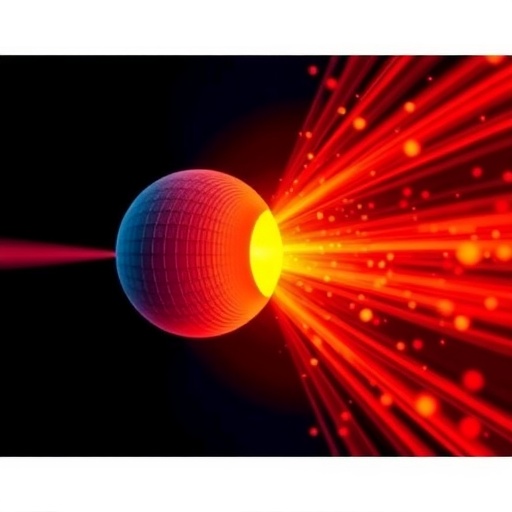In the ever-expanding frontier of nanotechnology, researchers at Auburn University have made a groundbreaking discovery that enhances our understanding of dusty plasmas and their interaction with magnetic fields. Dusty plasmas, which are a unique state of matter composed of micro-sized particles suspended in a charged gas, offer promising applications in fields ranging from electronics to space technology. The latest findings published in the esteemed journal Physical Review E unveil how weak magnetic fields can significantly influence the dynamics of these particulates, ultimately altering their growth patterns and characteristics.
At the heart of this study lies the complexity of dusty plasmas, which exist both in terrestrial laboratories and the eerie expanses of space. Dusty plasma consists of charged gas atoms that collide and interact with micro-sized dust particles. The research team, led by physicist Bhavesh Ramkorun, conducted a series of experiments elucidating how even the faintest magnetic fields sway the behavior of these tiny particles. The experiment involved manipulating carbon nanoparticles, grown in a specified mixture of argon and acetylene gases, while these particles hovered amidst the magnetic influence.
The presence of magnetic fields had a dramatic effect on the nucleation and growth of nanoparticles. Under regular conditions, these particles would steadily grow for approximately two minutes, a duration that allows for gradual particle expansion. However, when subjected to a magnetic field, this timeline drastically shrank, with particle growth occurring in less than a minute. Additionally, the application of magnetic forces resulted in the nanoparticles ultimately developing smaller diameters. The implications of such research are far-reaching, as these effects have the potential to refine and streamline the manufacturing processes for nanomaterials, leading to enhancements in technology sectors such as renewable energy and advanced electronics.
As the electrons within the plasma act as primary players in these interactions, their response to magnetic fields becomes critical. When magnetized, electrons follow curved trajectories that dictate overall plasma behavior. Co-author Saikat Thakur emphasized this point, stating, “When electrons are influenced by magnetic forces, they dictate the way in which the entire dusty plasma system operates.” This relationship highlights a fundamental aspect of plasma physics, wherein the lightest constituents can dictate the characteristics and evolution of the entire system. By probing the intersection of magnetism and dusty plasmas, researchers are not only grasping the physics behind nanoparticle growth but are also illuminating broader principles that govern astrophysical phenomena.
Furthermore, the insights gleaned from these experiments could foster the development of innovative plasma-assisted techniques for synthesizing nanoparticles with predetermined properties. For industries seeking advanced materials for coatings, electronics, or quantum computing devices, refining the control over nanoparticle formation is essential. By tailoring the conditions under which nanoparticles are created, scientists can engineer materials that meet specific functional requirements, offering substantial advantages over traditional methods of nanoparticle synthesis.
The realm of dusty plasmas extended beyond the laboratory and into the cosmos, where these phenomena shape natural occurrences such as planetary ring systems and stellar atmospheres. The research provides a critical link between experimental observations on Earth and cosmic phenomena, expanding the understanding of how nanoparticle interactions may behave under the influence of magnetic fields throughout the universe. As Ramkorun points out, “Dust and plasma interaction is a fundamental aspect of astrophysics. By studying particles with magnetic influence, we can decipher patterns that connect terrestrial observations with cosmic truths.”
In summary, this groundbreaking research from Auburn University sheds light on the delicate interplay between magnetic fields and the behavior of dusty plasmas, unveiling a mechanism that allows control over the growth and characteristics of nanoparticles. The findings not only enhance our fundamental understanding of plasma physics but also open avenues for advanced applications in nanotechnology. By carefully manipulating the conditions under which nanoparticles are formed, researchers can pioneer new technologies that leverage the unique properties of these materials, pushing the boundaries of what is possible in electronic devices, coatings, and beyond.
The Department of Physics at Auburn University remains a beacon of innovative research, combining rigorous experimentation with theoretical advancements. Graduate admissions are currently open, providing aspiring physicists the opportunity to engage in cutting-edge research and contribute to the ongoing exploration of plasma physics. As interest in this field grows, the work being carried out at Auburn underscores the significance of collaborative research in understanding the complexities of matter and its interaction with forces at the nanoscale.
In conclusion, as the scientific community continues to unravel the intricate relationships between magnetic fields and dusty plasmas, the potential applications within technology and space science remain vast. This research exemplifies how theoretical inquiry and experimental study converge to generate insights that propel both academic understanding and practical applications forward. The world of nanoparticles holds immeasurable potential, and as these discoveries unfold, the boundaries between fundamental physics and practical impact become increasingly intertwined.
Subject of Research: Dusty plasmas and magnetic field interactions
Article Title: Electron magnetization effects on carbonaceous dusty nanoparticles grown in Ar−C2H2 capacitively coupled nonthermal plasma
News Publication Date: 21-Oct-2025
Web References: DOI link
References: Physical Review E
Image Credits: Plasma Group – Department of Physics – Auburn University
Keywords
Dusty plasma, nanoparticles, magnetic fields, Auburn University, nanotechnology, plasma physics, electron magnetization, nanoparticle growth, experimental study.
Tags: Auburn University physics studycarbon nanoparticles manipulationcharged gas interactionsdusty plasmas researchexperimental nanotechnology techniquesgrowth patterns of nanoparticlesmagnetic fields in nanotechnologymagnetized plasmasnanomaterial design breakthroughsnanotechnology and electronicsplasma dynamics and applicationsspace technology innovations





